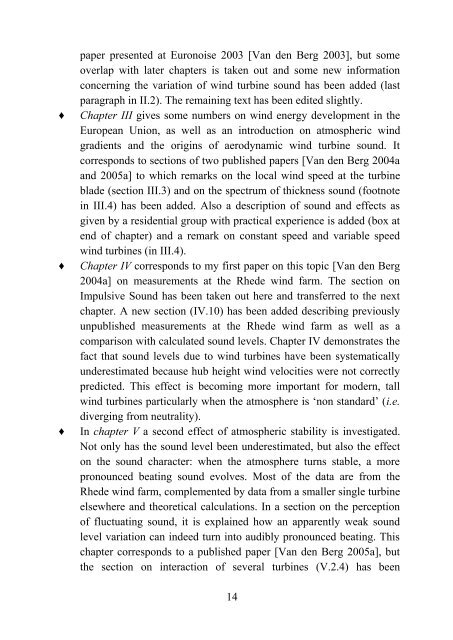The sounds of high winds
The sounds of high winds
The sounds of high winds
Create successful ePaper yourself
Turn your PDF publications into a flip-book with our unique Google optimized e-Paper software.
paper presented at Euronoise 2003 [Van den Berg 2003], but some<br />
overlap with later chapters is taken out and some new information<br />
concerning the variation <strong>of</strong> wind turbine sound has been added (last<br />
paragraph in II.2). <strong>The</strong> remaining text has been edited slightly.<br />
Chapter III gives some numbers on wind energy development in the<br />
European Union, as well as an introduction on atmospheric wind<br />
gradients and the origins <strong>of</strong> aerodynamic wind turbine sound. It<br />
corresponds to sections <strong>of</strong> two published papers [Van den Berg 2004a<br />
and 2005a] to which remarks on the local wind speed at the turbine<br />
blade (section III.3) and on the spectrum <strong>of</strong> thickness sound (footnote<br />
in III.4) has been added. Also a description <strong>of</strong> sound and effects as<br />
given by a residential group with practical experience is added (box at<br />
end <strong>of</strong> chapter) and a remark on constant speed and variable speed<br />
wind turbines (in III.4).<br />
Chapter IV corresponds to my first paper on this topic [Van den Berg<br />
2004a] on measurements at the Rhede wind farm. <strong>The</strong> section on<br />
Impulsive Sound has been taken out here and transferred to the next<br />
chapter. A new section (IV.10) has been added describing previously<br />
unpublished measurements at the Rhede wind farm as well as a<br />
comparison with calculated sound levels. Chapter IV demonstrates the<br />
fact that sound levels due to wind turbines have been systematically<br />
underestimated because hub height wind velocities were not correctly<br />
predicted. This effect is becoming more important for modern, tall<br />
wind turbines particularly when the atmosphere is ‘non standard’ (i.e.<br />
diverging from neutrality).<br />
In chapter V a second effect <strong>of</strong> atmospheric stability is investigated.<br />
Not only has the sound level been underestimated, but also the effect<br />
on the sound character: when the atmosphere turns stable, a more<br />
pronounced beating sound evolves. Most <strong>of</strong> the data are from the<br />
Rhede wind farm, complemented by data from a smaller single turbine<br />
elsewhere and theoretical calculations. In a section on the perception<br />
<strong>of</strong> fluctuating sound, it is explained how an apparently weak sound<br />
level variation can indeed turn into audibly pronounced beating. This<br />
chapter corresponds to a published paper [Van den Berg 2005a], but<br />
the section on interaction <strong>of</strong> several turbines (V.2.4) has been<br />
14
















